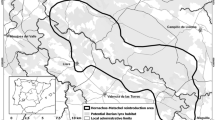Abstract
The behaviour of a free-ranging female lynxLynx lynx Linnaeus, 1758 and her kittens at 12 different kills was studied for 44 hours of observation from September 1996 to March 1997. The development of interactions at kills of a lynx family group showed the following pattern: until the end of September we often observed two lynx, usually both kittens, feed from the kill at the same time. After the age of four months aggression between kittens was observed frequently, with the bigger kitten being dominant. From September the kittens were never again seen feeding together at the kill. However, we never observed fighting, and aggressive behaviour did not increase with the age of the kittens. Whereas until December one of the kittens was always first at the kill, from January onwards it was mostly the adult female who ate first. She introduced her kittens to the home range of a neighbouring female where the family break-up occurred. The kittens were last seen together with their mother on 26 March. Dispersal seemed to be initiated by the female abandoning the kittens.
Similar content being viewed by others
References
Beier P. 1995. Dispersal of juvenile cougars in fragmented habitat. The Journal of Wildlife Management 59: 228–237.
Breitenmoser U., Kaczensky P., Dötterer M., Breitenmoser-Würsten C., Capt S., Bernhart F. and Liberek M. 1993. Spatial organisation and recruitment of lynx(Lynx lynx) in a reintroduced population in the Swiss Jura Mountains. Journal of Zoology, London 231: 449–464.
Jobin A., Molinari P. and Breitenmoser U. 2000. Prey spectrum, prey preference and consumption rates of Eurasian lynx in the Swiss Jura Mountains. Acta Theriologica 45: 243–252.
Literak I., Literakova M. and Klimes J. 2000. Observations on feeding order in a group of Eurasian lynx. Acta Theriologica 45: 427–430.
Naidenko S. V. 1998. Interrelations of individuals within family groups and possible reasons for disintegrating litters in lynxes (Lynx lynx, Carnivora, Felidae). Russian Journal of Zoology 77: 1317–1320.
Schmidt K., Jędrzejewski W. and Okarma H. 1997. Spatial organization and social relations in the Eurasian lynx population in Biaŀowieża Primeval Forest, Poland. Acta Theriologica 42: 289–312.
Schmidt K. 1998. Maternal behaviour and juvenile dispersal in the Eurasian lynx. Acta Theriologica 43: 391–408.
Sokolov V. E., Naidenko S. V. and Serbenyuk M. A. 1994. Specific fights of young lynxes (Felis lynx, Carnivora, Felidae). Russian Academy of Science 73: 132–137.
Wolff J. O. 1993. What is the role of adults in mammalian juvenile dispersal? Oikos 68: 173–176.
Zimmermann F. 1998. Dispersion et survie des Lynx(Lynx lynx) subadultes d’une population réintroduite dans la chaîne du Jura. M Sc thesis, University of Lausanne, Lausanne: 1–50.
Author information
Authors and Affiliations
Rights and permissions
About this article
Cite this article
Molinari, P., Molinari-Jobin, A. Behavioural observations of interactions in a free-ranging lynxLynx lynx family at kills. Acta Theriol 46, 441–445 (2001). https://doi.org/10.1007/BF03192451
Received:
Accepted:
Issue Date:
DOI: https://doi.org/10.1007/BF03192451




